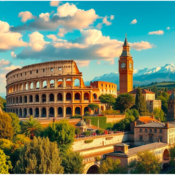Best 6 Amazing National Parks to Visit in Alaska

Best 6 Amazing National Parks to Visit in Alaska
Alaska has more national parks and preserves than any other state. Travelling in Alaska is about seeing an enormous midnight sun on Earth and exploring its numerous national parks and outstanding natural landmarks. From beautiful lakes to towering mountains and glacier-filled valleys, there are many worthy places to check out while visiting Anchorage, Fairbanks, Juneau and more. Visitors can explore and experience the natural beauty of world-class scenery and wildlife in Alaska. Here are six of the best national park in Alaska to visit:
1. Denali:

Denali National Park and Preserve are located on the east side of Cook Inlet. It is the most visited and well-known national park in America. The park includes a considerable part of the Alaska Range. It is home to Mount McKinley, aka “Denali” to locals. Denali is a photographer’s paradise with more than 70 peaks rising above 13,000 feet above sea level and over 2,000 miles of trails. The park has high alpine terrain with cirques, impressive glacial valleys and moraines. It also has billowing snowcapped mountain ridges, pure white glaciers and waterfalls surrounded by jagged peaks. For many, this place is synonymous with adventure and exploration, making it one of the most popular tourist destinations globally.
2. Wrangell-St-Elias in Alaska:

Wrangell-St Elias National Park is the world’s largest and most stunning park. It surrounds over 14 million acres, a vast and remote wilderness. Still, it is not just about the massive size – it’s about the variety of landscapes. You’ll experience as you travel across this part of Alaska. This national park is a perfect place to visit with your family. From May to September, it’s possible to reach Wrangell-St Elias on a shuttle bus from GlennallenIt. It offers incredible hiking and camping opportunities, awe-inspiring scenery and wildlife. You’ll find many geologic features, such as arctic mountain peaks, glacier-carved valleys and glacial lakes.
3. Alaska’s Katmai National Park:

Katmai National Park is located in southeastern Alaska on the southern coast of Katmai. It is an island with an area of about 461 square kilometers. One of the world’s largest volcanoes, Mount Katmai, is restricted by a caldera 2.5 kilometers in diameter and 1136 meters deep. The islands surrounding Katmai have yielded over 30 million specimens of dinosaur remains and other prehistoric creatures, including those discovered here at Katmai National Monument. During the visits to this landscape, there was a view from the upper side of the volcano called “unforgettable if you saw it Once” by Tracy Molloy.
4. Gates Of Artic:

Northern Alaska is where the Gates of Arctic National Park & Preserve is located. Over 8 million acres of the nation’s most unspoiled and wild terrain are found within the park. The Brooks Range, a rough range of mountains that crosses northern Alaska, can be located in the park.
The park’s John River, the Kobuk River, and other lakes or rivers allow paddling and rafting. Although there are no marked paths, tourists can trek in the park, and primitive camping is authorized. Travellers can only fly or walk to the park because it is not approachable by car. Several tiny towns near the park provide accommodations and transport services for tourists. The park offers a unique and remarkable trip, but tourists must be prepared for a challenging and independent experience.
5. Kenai FJords:

The Kenai Fjords Park includes over 670,000 acres on Alaska’s southern shore. Whales, sea lions, and other aquatic &terrestrial creatures can be seen throughout the park. Boat rides are available for tourists to witness these creatures and the magnificent mountains from the Harding Icefield. It will take up more than half of the park.
Tourists can engage in outdoor pursuits at the park, such as hiking, kayaking, and fishing. Many hiking trails, from small strolls to longer, more difficult excursions, provide spectacular countryside views. A well-known method for exploring fjords and getting up close to animals by kayaking. Travellers may explore Alaska’s distinctive coastal habitat and discover its rich cultural history at the stunningly gorgeous and diverse Kenai Fjords National Park.
6. Glacier Bay (Alaska):

Southeast Alaska, close to Juneau, is a breathtaking wildlife region called Glacier Bay National Park. Over 3 million acres of the park are covered by various environmentally friendly elements, such as glaciers, mountains, fjords, and coastal rainforests. More than a dozen glaciers in the park, especially the well-known Margerie Glacier, one of its more active tidewater mountains. A boat tour allows tourists to observe the glaciers up close and even experience the rumblings of the ice breaking into the water.
Travellers can visit the unspoiled forest regions of the park on supervised hikes & kayak tours to see these magnificent species in their native habitat. The vast cultural history of Glacier Bay National Park is another unique attribute. The Huna Tribal House, a neighbourhood hub, informs tourists about its culture and history.
Anybody who appreciates outdoor activities and wants to discover the wonder of Alaska’s wildness should visit here.
Also Read: Places to Visit in France
Alaska’s national parks are a living example of nature’s untouched splendour. Each park offers a distinctive combination of landscapes, wildlife, and adventure, from the majestic peaks of Denali to the frozen beauties of Glacier Bay. We may reestablish our connection to nature by visiting these national parks and developing a deep respect for Alaska’s raw wildness.
Alaska’s top six national parks provide experiences that will astonish you, whether you’re a fan of animals, an enthusiastic hiker, or simply seeking tranquilly. These national parks are a gift from nature that is just waiting for someone to brave the wilds of Alaska to explore and appreciate.
Recent Posts
Europe Travel Guide: Best Places to Visit & Explore
15 Best Amazing Places to Explore in Scotland
9 Best Amazing Day Trip To Explore from Kyoto





